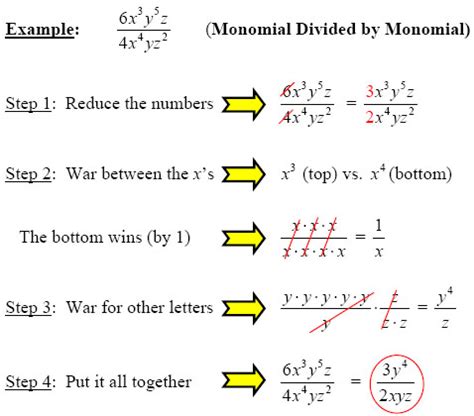Dividing A Polynomial By A Monomial Calculator
Greels
Mar 29, 2025 · 4 min read

Table of Contents
Dividing Polynomials by Monomials: A Comprehensive Guide
Dividing polynomials by monomials is a fundamental algebraic operation with broad applications in various fields, from calculus to engineering. Understanding this process is crucial for mastering more advanced mathematical concepts. This article provides a comprehensive guide to dividing polynomials by monomials, explaining the underlying principles, step-by-step procedures, and practical examples. We'll also explore how to leverage calculators and software for efficient computation.
Understanding Polynomials and Monomials
Before diving into the division process, let's clarify the terms "polynomial" and "monomial."
Polynomial: A polynomial is an expression consisting of variables and coefficients, involving only the operations of addition, subtraction, multiplication, and non-negative integer exponents of variables. Examples include:
- 3x² + 2x - 5
- 7y⁴ - 2y² + 1
- x³ + 5x²y + 2xy² - 6y³
Monomial: A monomial is a polynomial with only one term. It's a product of a constant and variables raised to non-negative integer powers. Examples include:
- 4x
- -2y²
- 5xy³
The Process of Dividing a Polynomial by a Monomial
Dividing a polynomial by a monomial involves applying the distributive property of division. Essentially, you divide each term of the polynomial by the monomial. This process can be represented as follows:
(axⁿ + bxᵐ + cxᵖ + ...)/d = (axⁿ)/d + (bxᵐ)/d + (cxᵖ)/d + ...
Where:
a,b,care coefficients.xis the variable.n,m,pare exponents.dis the monomial divisor.
Step-by-Step Guide: Dividing Polynomials by Monomials
Let's illustrate the division process with a step-by-step example:
Problem: Divide (6x³ + 9x² - 12x) by 3x.
Step 1: Rewrite the expression:
(6x³ + 9x² - 12x) / 3x
Step 2: Apply the distributive property:
(6x³/3x) + (9x²/3x) - (12x/3x)
Step 3: Simplify each term:
- (6x³/3x): Divide the coefficients (6/3 = 2) and subtract the exponents of x (3-1 = 2). This simplifies to 2x².
- (9x²/3x): Divide the coefficients (9/3 = 3) and subtract the exponents of x (2-1 = 1). This simplifies to 3x.
- (12x/3x): Divide the coefficients (12/3 = 4) and subtract the exponents of x (1-1 = 0). x⁰ = 1, so this simplifies to 4.
Step 4: Combine the simplified terms:
The final result is 2x² + 3x - 4.
Advanced Examples and Considerations
Let's explore some more complex scenarios:
Example 1: Polynomial with Multiple Variables:
Divide (10x³y² + 15x²y³ - 20xy⁴) by 5xy
Step 1: Rewrite the expression: (10x³y² + 15x²y³ - 20xy⁴) / 5xy
Step 2: Apply the distributive property: (10x³y²/5xy) + (15x²y³/5xy) - (20xy⁴/5xy)
Step 3: Simplify each term:
- (10x³y²/5xy) = 2x²y
- (15x²y³/5xy) = 3xy²
- (20xy⁴/5xy) = 4y³
Step 4: Combine the simplified terms: The final result is 2x²y + 3xy² - 4y³
Example 2: Dealing with Negative Coefficients and Exponents:
Divide (-8x⁴ + 4x³ - 12x²) by -4x²
Step 1: Rewrite the expression: (-8x⁴ + 4x³ - 12x²) / -4x²
Step 2: Apply the distributive property: (-8x⁴/-4x²) + (4x³/-4x²) - (12x²/-4x²)
Step 3: Simplify each term:
- (-8x⁴/-4x²) = 2x²
- (4x³/-4x²) = -x
- (12x²/-4x²) = -3
Step 4: Combine the simplified terms: The final result is 2x² - x + 3
Important Note: If any term in the polynomial has a lower exponent than the monomial divisor, the resulting term will be a fraction involving the variable in the denominator. For instance, if we divide (6x² + 3x + 2) by 3x, the last term becomes 2/3x.
Using Calculators and Software
While manual calculation is essential for understanding the underlying principles, calculators and mathematical software can significantly expedite the process, particularly for larger or more complex polynomials. Many graphing calculators and online tools are capable of performing polynomial division. These tools often provide step-by-step solutions, aiding in learning and verification.
Remember to always input the polynomial and monomial correctly according to the calculator's syntax.
Real-World Applications
The ability to divide polynomials by monomials is vital in numerous areas:
- Calculus: Finding derivatives and integrals frequently involves polynomial manipulations, including division by monomials.
- Engineering: Many engineering problems, particularly in areas like signal processing and control systems, rely heavily on polynomial analysis.
- Physics: Polynomial equations are commonly used to model physical phenomena, and their manipulation is often required for solving problems.
- Computer Science: Algorithm design and analysis often rely on polynomial operations for complexity analysis and problem-solving.
Troubleshooting Common Mistakes
Here are some common errors to avoid when dividing polynomials by monomials:
- Incorrectly applying the distributive property: Ensure you divide each term of the polynomial by the monomial separately.
- Errors in exponent subtraction: Remember to subtract the exponents of like variables.
- Sign errors: Pay close attention to the signs of the coefficients when dividing.
- Incorrect simplification: Double-check your simplification of each term before combining them.
Conclusion
Mastering polynomial division by monomials is a crucial step in developing strong algebraic skills. By understanding the underlying principles and practicing the steps outlined in this guide, you'll build a solid foundation for tackling more advanced mathematical challenges. Remember to utilize calculators and software strategically to enhance efficiency while retaining a grasp of the fundamental concepts. The practical applications of this skill extend far beyond the classroom, making it an essential tool in numerous fields.
Latest Posts
Latest Posts
-
44 Cm Is What In Inches
Mar 31, 2025
-
How Much Is 71 Inches In Feet
Mar 31, 2025
-
How Many Feet Is 173 Cm
Mar 31, 2025
-
What Day Was 29 Days Ago
Mar 31, 2025
-
How Much Is 300 G In Pounds
Mar 31, 2025
Related Post
Thank you for visiting our website which covers about Dividing A Polynomial By A Monomial Calculator . We hope the information provided has been useful to you. Feel free to contact us if you have any questions or need further assistance. See you next time and don't miss to bookmark.
